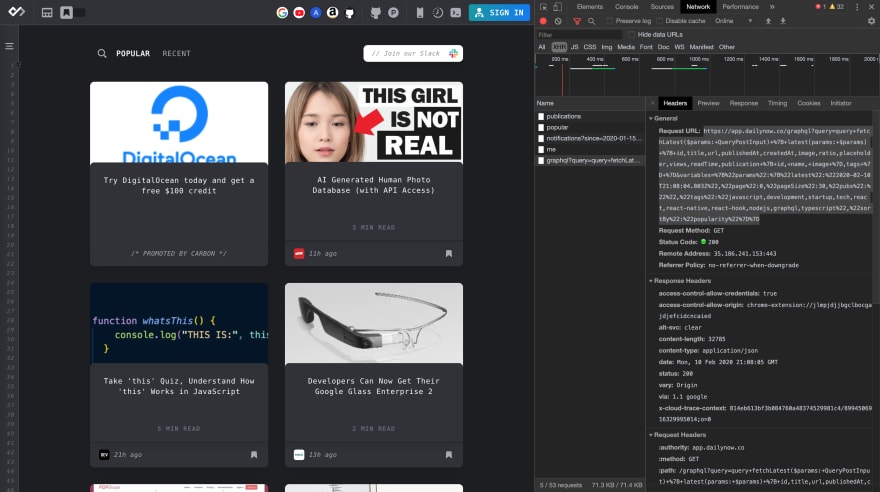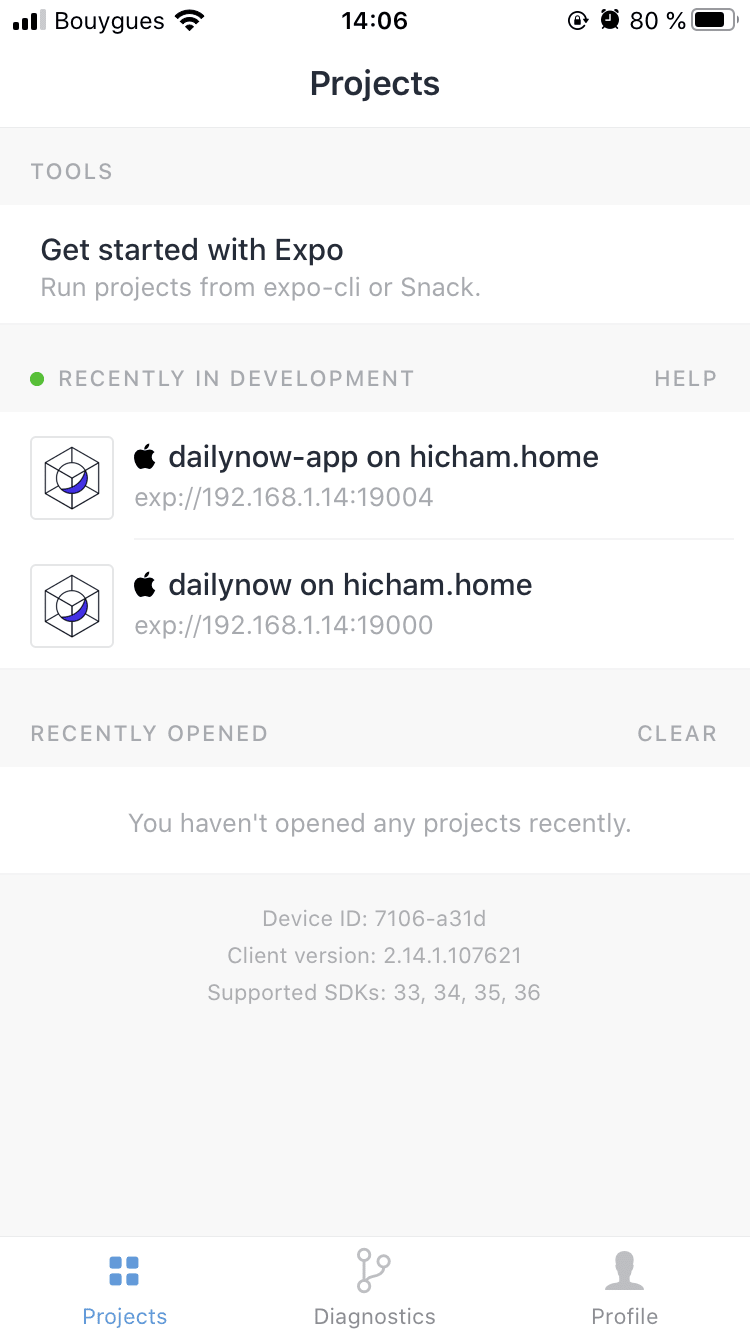How to create a Dailynow mobile app in few minutes with React-Native and Expo

ELABBASSI Hicham
Posted on February 10, 2020

As a developer, you might want to know what's new in the tech area. I advise you the very useful Chrome/Firefox extension called Dailynow. You need to install this extension to quickly retrieve the API url. In this tutorial, we are going to create a very simple Dailynow mobile app with react-native and the Expo sdk/platform. I create a github repo for this tutorial.
The first thing we are going to do is to create an Expo account and download the Expo client mobile app. Play Store | App Store.
You can now log in to the expo client mobile app.
You're now ready to create the application!
Open a terminal, install the expo-cli globally, create an expo project and log in to the expo-cli with the same expo account.
> yarn global add expo-cli or npm install expo-cli -g
> expo init
> expo login
Choose the blank (Managed workflow) template.
The app directory should look like this.

Replace the content of the current App.js file to this
import React from "react";
import { StatusBar, View, Text } from "react-native";
const App = () => {
return (
<>
<StatusBar barStyle="dark-content" />
<View style={{ marginTop: 20 }}>
<Text>App content</Text>
</View>
</>
);
};
export default App;
Go back to your terminal, run yarn start or npm run start and scan the QRCode with your phone to open the application.
You can also open the app with the Expo Client mobile app, you can see your app running in the projects tab (Your phone and your computer have to be in the same network).
Tadaa ! Now, you should see your application running on your phone.

Now, we will adapt the code to display a list of blog posts. Open the App.js file and add a FlatList component with some fake data.
import React from "react";
import { StatusBar, View, Text, FlatList, Image } from "react-native";
const data = [
{
id: "dd05fda7784c5943b08b45f438aafb51",
title: "AI Generated Human Photo Database (with API Access)",
url: "https://redstapler.co/ai-generated-human-photo/",
publishedAt: "2020-02-10T09:42:28.000Z",
image:
"https://res.cloudinary.com/daily-now/image/upload/f_auto,q_auto/v1/posts/1c8f48d32e75aa526cd4562928e46569",
tags: ["javascript", "ai", "others"]
},
{
id: "37b887d2ad3e5f79834e7555c49fec49",
title: "Take 'this' Quiz, Understand How 'this' Works in JavaScript",
url:
"https://dev.to/liaowow/take-this-quiz-understand-how-this-works-in-javascript-44dj",
publishedAt: "2020-02-09T21:28:29.000Z",
image:
"https://res.cloudinary.com/daily-now/image/upload/f_auto,q_auto/v1/posts/1110f8e9b4c54f5e0291c95da5171d00",
tags: ["javascript", "beginners", "challenge"]
}
];
const App = () => {
const handleKeyExtractor = item => item.id.toString();
return (
<>
<StatusBar barStyle="dark-content" />
<View style={{ marginTop: 20 }}>
<FlatList
data={data}
renderItem={({ item }) => (
<View style={{ flexDirection: "row", padding: 15 }}>
<Image
source={{ uri: item.image }}
style={{ width: 80, height: 80 }}
/>
<View style={{ flex: 1, paddingLeft: 10 }}>
<Text
style={{ fontSize: 16, fontWeight: "300" }}
numberOfLines={2}
ellipsizeMode="tail"
>
{item.title}
</Text>
</View>
</View>
)}
/>
</View>
</>
);
};
export default App;
Your app will automatically reload and should now look like this

Dailynow data
Open a Dailynow tab on your browser and open the Chrome/Firefox devtool (Network tab). Refresh the page and copy the https://.../graphql?... request url to the clipboard. This request will allow us to retrieve data from the dailynow API with your personal tags.

In the App.js component, you can now fetch the data in a useEffect hook and store the response in a state.
import React, { useEffect, useState } from "react";
import { StatusBar, View, Text, FlatList, Image } from "react-native";
const App = () => {
const handleKeyExtractor = item => item.id.toString();
const [data, setData] = useState();
useEffect(() => {
(async () => {
const response = await fetch(
"PASTE_REQUEST_URL"
);
const result = await response.json();
setData(result.data.latest);
})();
}, []);
return (
<>
<StatusBar barStyle="dark-content" />
<View style={{ marginTop: 20 }}>
<FlatList
data={data}
renderItem={({ item }) => (
<View style={{ flexDirection: "row", padding: 15 }}>
<Image
source={{ uri: item.image }}
style={{ width: 80, height: 80 }}
/>
<View style={{ flex: 1, paddingLeft: 10 }}>
<Text
style={{ fontSize: 16, fontWeight: "300" }}
numberOfLines={2}
ellipsizeMode="tail"
>
{item.title}
</Text>
</View>
</View>
)}
/>
</View>
</>
);
};
export default App;
Link to a blog post
Install the expo-web-browser module
expo install expo-web-browser
Add a TouchableOpacity component in the renderItem props.
import React, { useEffect, useState } from "react";
import {
StatusBar,
View,
Text,
FlatList,
Image,
TouchableOpacity
} from "react-native";
import * as WebBrowser from "expo-web-browser";
const App = () => {
const handleKeyExtractor = item => item.id.toString();
const [data, setData] = useState();
useEffect(() => {
(async () => {
const response = await fetch(
"PASTE_REQUEST_URL"
);
const result = await response.json();
setData(result.data.latest);
})();
}, []);
const openPost = async link => {
await WebBrowser.openBrowserAsync(link);
};
return (
<>
<StatusBar barStyle="dark-content" />
<View style={{ marginTop: 20 }}>
<FlatList
data={data}
renderItem={({ item }) => (
<TouchableOpacity onPress={() => openPost(item.url)}>
<View style={{ flexDirection: "row", padding: 15 }}>
<Image
source={{ uri: item.image }}
style={{ width: 80, height: 80 }}
/>
<View style={{ flex: 1, paddingLeft: 10 }}>
<Text
style={{ fontSize: 16, fontWeight: "300" }}
numberOfLines={2}
ellipsizeMode="tail"
>
{item.title}
</Text>
</View>
</View>
</TouchableOpacity>
)}
/>
</View>
</>
);
};
export default App;
That's it! Now take a look at the application.
A lot of features can be added very quickly to this application:
- Refresh
- Inifinite scroll
- Dark mode
- Tags settings
- Bookmarks
I create a github repo for this tutorial that includes some of those features. Feel free to contributes :D
You can also publish your expo app with one command line expo publish. This allows you to access the app from every were. All your published apps are accessible in the expo client mobile app (Profile tab).
Thanks to the dailynow team for their awesome work!

Posted on February 10, 2020
Join Our Newsletter. No Spam, Only the good stuff.
Sign up to receive the latest update from our blog.
Related
June 22, 2022


